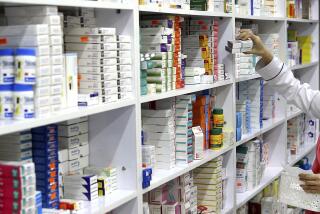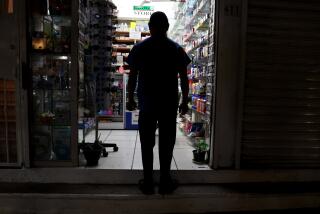The Prescription for Safe Drugs Abroad: Bring Them From Home
When Dr. Terri Rock counsels patients who are planning lengthy overseas trips, especially if they are backpacking or headed to a developing country, she always includes information on medications. She describes the medications they should take beforehand, and she tells them about medicines they should take along in case of traveler’s diarrhea or other ailments.
If the list gets lengthy, Rock’s patients, especially those on a budget, often complain about the cost. They may tell her they will get some prescriptions filled before leaving but save refills or just-in-case drugs for their destination.
Rock, a Santa Monica family practice physician with a special interest in travel medicine, gently suggests that this approach is penny wise but pound foolish because of the risk of receiving fake or substandard drugs abroad.
Long a concern of global health experts, counterfeit or substandard drugs can threaten a traveler’s health. Two recent reports published in the British medical journal the Lancet found alarmingly high occurrences of problem drugs overseas.
Drugs obtained outside the U.S. may not contain enough active ingredient, or they may be chemically unstable when stored in warm climates. Poor quality control during manufacturing can compromise a drug’s effectiveness. Some medicines are contaminated with foreign substances. And at times a drug is simply fake, passed off as the real thing but containing no active ingredient.
Agencies such as the World Health Organization are working to combat the problem, and some countries have strengthened efforts to require random sampling and monitoring of drugs.
According to reports in the Lancet, one research team collected 581 samples of 27 medications, including antimalarials, antibiotics, antifungals and others, from 35 pharmacies in Nigeria. They found that nearly half the samples somehow fell short; they had too little active ingredient, too much or none at all. The other team bought 104 samples of the antimalarial artesunate from pharmacies in Cambodia, Laos, Myanmar, Thailand and Vietnam and found that 38% did not in fact contain artesunate. The researchers could not tell fake drugs from real ones by the cost or appearance of the tablets or by the packaging, they said.
At a meeting of the American Society of Tropical Medicine and Hygiene this month in Atlanta, scientists from the federal Centers for Disease Control and Prevention reported that low-tech, hand-held refractometers could help detect fake drugs. (Refractometers are used to determine a substance’s specific gravity, its density compared with a standard such as distilled water.)
In a laboratory study, they found that the specific gravity of a drug sample, calculated after dissolving the drug in alcohol, can be compared with the specific gravity of the benchmark drug. The resulting comparison is used to assess the amount of active ingredient in the sample, the CDC’s Michael D. Green told colleagues at the meeting.
Refractometers, which cost about $85, could help officials in developing countries assess their drugs and help U.S. officials screen drugs imported from overseas or sold by the Internet to U.S. customers. Green plans to conduct field studies of the device overseas.
Meanwhile, what can travelers do? Be wary of buying medicines in a developing country, experts say. Although there’s no hard-and-fast list of which countries have problems, some experts suggest that “if you worry about the water, worry about the medicine.”
And go armed with information, Rock says. When she tells patients about diseases in their destination countries, she writes down the generic and brand names of drugs that might be needed, along with the manufacturer--for instance, “ciprofloxacin, Cipro, Bayer.” And she alerts them that the brand name can differ from country to country, so it’s wise to confirm that the drug’s generic name and manufacturer match those she provides. Rock also advises patients to be sure the drug is in its original packaging.
If travelers are going to several countries, she suggests they buy a guidebook that lists medica-tions by their U.S. and foreign names. One series, “Travelers Guide to International Drugs” (in four volumes, organized by area; $14 each), is described online at https://www.medicalsurveillance.com.
Rock uses these books.
Ideally, travelers should take all the medicines they think they will need, especially on a trip to a developing country, says Susan Winckler, a pharmacist and spokeswoman for the American Pharmaceutical Assn.
“Take the medicine in bottles that have the prescription labels on them,” she adds. This can be the original bottle, or you can ask the pharmacy to make up another label for you and put it on a smaller bottle for travel, she says. Doing this decreases hassles going through Customs, she says, and can make it easier to get refills of exactly the same medicine if you need them.
“Depending on the country, the drug name may not be required to be on the label,” Winckler says. Be sure you have the name of the drug, clear instructions on how to take it and information about potential side effects, she adds.
Apart from the problem of fake or substandard drugs, be aware that at times a pharmacist tries to pass off one medication for another.
For instance, Rock once asked for mefloquine (sold under the brand name Lariam) in Tijuana pharmacies and was offered chloroquine (Aralen or other brands), which doesn’t work against the type of malaria found in many parts of the world.
U.S. citizens regularly cross the border to Mexico or Canada in search of cheaper medications--most recently ciprofloxacin, used to fight anthrax--but pharmacy experts say they can’t be sure they are receiving the same medications they would at home.
*
Healthy Traveler appears twice a month.
More to Read
Sign up for Essential California
The most important California stories and recommendations in your inbox every morning.
You may occasionally receive promotional content from the Los Angeles Times.










